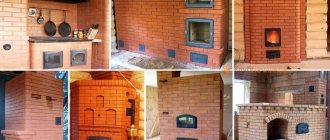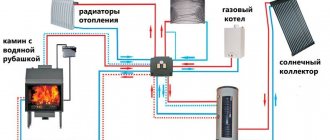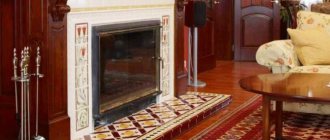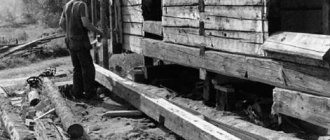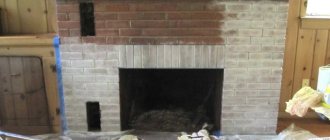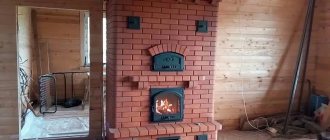Why painting is needed
A stove in the house is an interesting design solution that allows you to significantly save on space heating. Previously, brick structures were not treated with anything; at most, they were plastered or covered with lime. The stoves did not have a presentable appearance, and the lime coating very quickly lost its appearance. Today, construction stores sell a lot of facing material that can be used to cover brick stove walls, but this option is expensive, unlike painting.
Therefore, the brick structure needs to be painted, but the composition of not every substance is suitable for this process.
During heating, brick elements joined together with cement mortar begin to lose their tightness over time. Clay plaster prevents this process, but it is not presentable, and paint can improve the appearance of the stove and also provide additional protection to the plaster composition. There are many paint options that are not sensitive to high temperatures and changes.
Regular paintwork quickly cracks and smokes heavily in the chimney area. The first problem will be solved by a high-quality composition adapted to the increase in temperature, and the second by finishing the furnace arch with additional elements.
Destruction of brick if it is not processed or the preparatory process is neglected Source www.remontnik.ru
It is important not only to choose the right paint, but also to prepare the surface and properly care for it in the future. The work is carried out in several stages.
Do I need to paint or is there an alternative?
homemade metal stoves do not always resort to painting them, apparently believing that this is done solely for the sake of appearance, and if the stove is not visible under a brick screen, then it is not worth spending money on painting it.
In principle, any metal will burn out over time . After all, why do cast iron stoves last so long? Their wall thickness is many times greater than that of steel, which is why they burn out longer.
Castor stove - factory paint scorched
The paint layer prevents not only the metal from rusting from water, but also its burnout (also corrosion, by the way). Therefore, painting, in general, is beneficial, but such a coating also does not last forever (although there is a guarantee for many years). Therefore, let’s say this: if it’s cheaper for you to weld a new stove than to paint it, then it’s clear that you won’t paint it.
Unfortunately, by applying water to the stones, you still contribute to the oxidation of the metal. Steels rust quickly, and even stainless steels without certain additives oxidize when exposed to high temperatures. And black (carbon) steels generally rust instantly.
But silicone paints did not always exist; was there any alternative?
Information from Wikipedia
Yes, I was. Metal can be blued. Moreover, this applies to both steel and cast iron. With the help of various reagents or reagents and high temperature, a protective film of oxidized iron . It is logical to assume that ordinary rust should also then be considered a protection - this is partly true, but it is loose, so it does not interfere with the further penetration of oxygen.
The film obtained by bluing (= blackening) metal is much stronger. It can be obtained using acids or alkalis. One way is as follows:
15 grams of tartaric acid and 280 grams of concentrated phosphoric acid should be poured into a liter of water. Use the resulting solution to treat a metal surface that has been cleaned to a shine. Wash off excess acid with laundry soap . And then heat the stove to 150 degrees and apply a layer of caustic soda (NaOH) to the surface - you can spray it with a spray bottle, but with great care - caustic soda leaves chemical burns not only on the skin, but also on the respiratory system.
IMPORTANT! When working with chemicals, protect your skin, eyes, and nasopharynx!
After an hour the surface will be black. Be sure to preheat the oven!
There are, of course, methods of cold bluing, but there are different ingredients. If you can get antimony trichloride , mix it half and half with olive oil and rub it into the surface prepared with acid and laundry soap (as described above). The paste is applied once a day, the next day it is completely removed and a new layer is applied.
If all these procedures seem too dangerous and time-consuming to you, you can simply cover the stove with either a stainless steel or a brick screen, but this will not really help save it from corrosion. Consequently, either unsafe bluing or expensive thermal paint.
Types of paints
Leaving the stove structure in its natural, unprocessed form is not the best solution. If you do not want to hide the brick surface, then it is enough to cover it with colorless paint. This event will not hide the relief of the walls, but will protect the coating from negative factors and make the overall appearance attractive. To understand how to paint a brick stove in a house, you need to learn more about the options for dyes and their compositions.
Types of paintwork:
- Water-based acrylic substances . They have a budget price and are easy to apply with a regular brush or roller. The only drawback of this paint is that it is afraid of humidity, so it is not advisable to use it where this indicator is high.
- Polyurethane . They are famous for their heat resistance. Their heating limit is up to 600 degrees, but a side effect is possible. Some polyurethane paints may discolour slightly.
Stove painted with polyurethane composition Source www.remontnik.ru
- Organosilicon enamels . Unlike previous types, they are more expensive in price, but have many advantages. They can withstand temperatures up to 800 degrees, are made from environmentally friendly materials, have an increased durability, and do not contain toxic substances. During operation, economical consumption is observed.
- Substances based on lime and chalk . Not suitable for red brick, they are inexpensive, penetrate well into stone, have an antifungal effect and are easy to apply.
Disadvantages of lime products:
- Requires multiple applications.
- Touch-up is required (at least once every two years).
- There is a risk of incorrectly calculating the consistency.
- The brick wall must first be treated with water-based paint or plastered, which means additional costs and time.
If the owner of the house decides to start processing and does not know how to paint the brick stove in the house, it is better to give preference to silicone enamel. It will not cause harm to residents, will ensure the safety of the brick, and will create a presentable appearance of the stove structure.
Practical use of colorless silicone enamel for ovens Source istopnik.su
See also: Catalog of companies that specialize in paints and varnishes.
Chalk based whitewash
Chalk is an inexpensive natural material that is easy not only to apply, but also to wash off. Using chalk you can get a rich white color, but every time you touch the stove it will leave white marks on your clothes. For whitewashing, chalk is used in powder form, which is sold in hardware and construction stores. When diluting chalk, do not be afraid of the gray tint of the solution - after drying, the stove will become crystal white!
The chalk solution may have a gray tint, but the dry oven will be snow-white
To prepare the solution per liter of water, take 800 grams of dry chalk, but stove makers advise using skim milk instead of water, and adding natural laundry soap and wood glue for strength.
First, one and a half kilograms of sifted chalk are diluted in 3 liters of milk, after which the mixture is heated and a piece of grated soap and 100 grams of wood glue are added, continuing heating until the ingredients are completely dissolved. It is important to prevent the liquid from boiling! Before whitewashing the stove, the solution is filtered through cheesecloth and applied to the surface while warm.
Criterias of choice
There are a lot of paint and varnish products in construction stores. If you are not knowledgeable about paints, pay special attention to the information on the packaging. Basic information:
- compound;
- appointment;
- humidity indicators;
- manufacturer;
- price.
There are various varnishes, paints, enamels that have a high-quality composition, but are not suitable for a home brick oven, but are intended exclusively for industrial premises or the street. The packaging should be marked “heat resistant”.
When purchasing paint, you should make sure that it has a certificate. Dubious products are created from untested ingredients, which can lead to loss of health, not to mention the attractiveness of the paintwork. High-quality paint cannot cost less than 135 rubles per kg.
When considering options for painting a brick stove in your home, it is important to pay attention to the temperature indicator declared by the manufacturer and the protective functions. You should choose those brands that are offered by companies that have their own factories for the production of paints and varnishes and quality control.
Organosilicon enamels of different companies, variants and shades Source 2gis.com
Tooth powder solution
This recipe cannot be called the cheapest, but it has many admirers who claim that the finish does not get dirty and retains its original appearance for a long time, and the stove can be lit on the very first day after painting.
To prepare the solution, take 4 packages of tooth powder, 4 egg whites, and a glass of milk. All ingredients are mixed and allowed to brew for 10-15 minutes. The consistency of the composition should be similar to oil paint. This mixture is applied to a heated oven so that the milk and eggs “set” and gain strength. As the product is consumed, a new portion is prepared.
Preparatory process
Having chosen what to cover the red brick stove in the house with, additionally purchase tools for work, clean and prepare the surface.
Main events:
- clean from dust and dirt,
- putty the cracks,
- remove chips.
On a note ! A folk method that will help get rid of minor flaws is to apply a mixture of egg white and homemade milk to a warm oven.
Inventory and additional building materials:
- dye;
- roller, brush, spray gun or compressor;
- tools for cleaning uneven surfaces (soft sandpaper);
- protective clothing: gloves, goggles, mask;
- rags.
A combination of several types of paints in finishing a stove Source rio-max.ru
Important ! In the room before work, the furniture, floor, and walls are covered.
Rules for high-quality whitewashing of a stove with lime and chalk solutions
Content
Expensive lining of stoves with tiles and stone was available only to the wealthy segments of the population, and peasants coated stoves with clay and whitewashed them every season to refresh the situation and renew the wet nurse. In modern homes, whitewashing the stove with your own hands is the most affordable way to decorate the hearth. In order for the whitewash to adhere well and not leave marks on clothes, you need to properly prepare the solution and follow all recommendations for preparing the surface and applying the mixture.
Painting
After choosing what to paint the stove in the house with, purchasing materials, preparing the surface, they put on protective clothing, take the tools they are going to use, and begin the painting process.
Step-by-step instruction:
- Close windows and doors to prevent drafts. Air currents will increase the likelihood of dust and small particles settling on the painted surface, which will negatively affect the appearance of the stove after complete drying.
- Thin the paint first if it is thick. Some experts recommend filtering the substance through cheesecloth to make sure that there are no garbage elements in it. This is also important if you decide to use a spray gun, so that the operation of the device is not hampered. This is also necessary when using paint of questionable manufacture.
- Regardless of the type of tool that is used, the work involves a certain algorithm for applying the composition: first the edges are processed, then the depressions and inconvenient places, then the main area.
What you need to know when applying
There are a number of factors to consider before painting with heat-resistant varnish. The most significant are the following:
- According to the manufacturer's instructions, the composition can be worked at temperatures ranging from -40°C to +40°C. However, they also recommend painting at +15C - +20°C.
- Before starting work, the composition must be mixed to a homogeneous consistency.
- Painting is performed only on cleaned, dried and primed surfaces.
Recommendations from experts
The main task of the paint is to create an attractive appearance for the brick and protect the surface. No matter how high-quality the product is, over time cracks appear on the painted layers. This is a common decomposition reaction of the substance, but the period can be increased if the painting is carried out correctly and you take into account the advice of experts:
- The correct choice of what paint to paint the brick stove in the house is the main point that will eliminate minor nuances in the future. You should not buy cheap products. Such savings will require double costs in the future.
One of the ways to dilute paint in a separate container Source sdelalremont.ru
- If the paint is too thick, then it must be diluted only with a solvent.
- The density of the fresh substance should be kefir mass. This composition will not require dilution and will not spread during application.
- To increase the strength of the mixture at home, it is recommended to add 40-50 g of table salt per jar. It is important to first dilute it in warm liquid.
- If there are old layers of paint or lime on the stove, they should be removed. The limescale composition can be easily removed with water, and soft sandpaper can be used to remove paint.
- When purchasing brushes, you should not save money on them. It is better to buy a wide tool with natural bristles. When purchasing them, you should check them and touch the fibers. They should be soft but elastic.
- If you decide to use a roller, it should be made of foam rubber or short-pile fur.
- Many paint manufacturers write on the packaging that it is enough to apply one coat of paint, but experts advise working in three stages. First, a “rough” layer is applied, then the main one, and only after that the finishing layer.
Applying the first layer Source gidpokraske.ru
On a note! Drying thoroughly and applying additional layers will not only increase durability, but also deepen the color.
- Do not mix several types of enamels. It is prohibited to apply paint and varnish without first preparing the surface.
- Before buying paint, it is better to calculate the oven area to find out how much dye to purchase. This will save money.
After completing the work, it is better to close the room for a day and, if possible, not enter there. After 24 hours, you can already go into the room to check the condition of the stove and open the windows for ventilation. When choosing what to coat a brick oven with and with what tools, pay attention to all types of paints in cans or bottles, except those in aerosol cans. The composition sprayed with their help lies unevenly on the surface of the oven, and additional layers will lead to differences in shade.
Result of coloring after applying the third layer Source centr-terrasnoi-doski.ru
DIY artistic painting
Stove with artistic painting
If desired, the stove can be decorated with a design. Folk motifs will add individuality to your home. Artistic painting is easy to do. Coloring composition:
- Dilute multi-colored gouache with water.
- Add 1-2 raw egg yolks to the mixture.
- Stir well until smooth.
- Use as directed within 12 hours.
The design can be applied with a painting brush or with a sponge. The use of stencils is permitted. Painting depends on personal imagination. For beginners, it is better to use simple patterns.
In addition to the egg coloring mixture, the remaining whitewash is used - gouache is added to the solution. High temperature oil paint can be used.
It is best to carry out all furnace work before the onset of autumn. Cast iron parts (oven, doors) are best treated with fire-retardant or silicon-organic enamels. This will protect them from corrosion.
Decor
We must not forget about additional decor and harmonious coverage. A stove arch often turns black from smoke, regardless of the quality of the brick coating. To cover this part of the stove, you can use metal elements or decorative stone overlays.
The color scheme is also important, which should be in harmony with the room and furniture. It is better to choose a color based on the shades of the floor, ceiling or walls. Remember, if clear enamel is used for painting, it will still have the tint of the wall.
If you decide to install additional decorative elements, then it is important to choose the right adhesive composition for them. Not all substances can hold elements on a painted wall for a long time.
You can create an unusual design using different paint colors. For example, paint all the bricks in different colors.
Combination of paint, lime and metal elements Source gidkaminov.ru
Professional products
In addition to the usual folk methods of whitewashing a stove, you can use industrial compounds. But first you need to decide on the types of materials and their main purpose. Let's consider several brands.
- "Master". This product is excellent as a whitewash for the stove, but the surface to be treated must first be prepared. Remove dust, clean dirt, seal cracks.
- “BRAVO” is a water-dispersed composition suitable for various types of coatings, including brick and stone walls. Does not rub off or fade with regular friction and exposure to high temperatures.
- "Flamingo". A good universal moisture-resistant composition that is suitable for covering stove structures, rough walls and nearby walls. It has a high degree of plasticity.
Professional whitewash hardens quickly and allows the use of decor on top of it Source haskidom.com
Before whitewashing the stove, all cracks on it must be sealed with putty Source kraski-net.ru
Experts recommend using an expensive, high-quality product once, rather than repainting and updating the surface every year.
Briefly about the main thing
Building a brick stove in a house or country house is far from the final stage in decorating a room. The stove structure also needs to be coated with paint.
Before decorating the structure with paints and varnishes, you should seal the cracks, treat the joints and clean up the irregularities. If you don’t figure out what paint to paint a brick stove with or don’t carry out additional surface treatment before painting, very soon the brick will begin to crumble.
The stove can be painted with polyurethane or silicone paint; the most budget-friendly method is ordinary lime whitewash.
It is important to follow the painting instructions: first treat hard-to-reach places and depressions with the composition, and only then apply the substance to the main area.
Ratings 0
conclusions
In currently popular interiors - country, chalet and shabby chic, the main highlight is the naturalness of various decorative elements and details. A classic Russian brick stove or fireplace fits especially well into them.
A brick stove is an excellent option for providing coziness and comfort in your home; it will give you the opportunity to watch the picturesque flames and provide warmth to your home. In order for the stove to look decent, it must be painted.
This can be done by choosing any method from the many provided. You can paint the stove with special paint from the store or prepare a composition for the coloring solution yourself. The main thing is that the paint is heat-resistant and durable.
The use of coloring agents for metal and with metallic substances in their composition is not recommended - they are not able to maintain their color and quality at high temperatures.
The best tree for a bathhouse is...
The classic design of both a Russian bath and a Finnish sauna involves interior decoration made of wood. Its obvious advantages are naturalness, environmental friendliness, aesthetics and accessibility. But you should know that not all types of wood can be used in bathhouse construction.
So, the most suitable and most popular are:
When constructing and finishing steam rooms, as a rule, preference is given to deciduous trees. The use of coniferous species is not at all advisable due to the possible release of resins when heated. And they, in turn, can have an extremely negative impact on human health.
Basic rules of work
As you can see, the process of applying varnish is quite simple and accessible to anyone. Use the right material, follow safety regulations, and your stove will look well-groomed and attractive.
Source
Which one is better to use?
How to paint a metal stove in a bathhouse? To do this, be sure to buy heat-resistant or organosilicon enamels and varnishes that can withstand heating up to 600 0 . The layer must maintain its solidity and prevent the formation of rust on the structural steel from which inexpensive bath “units” are made.
As a rule, dark colors are used, even black. It increases the heat transfer level of the furnace. Aluminum based paint is not recommended. The most in demand are organosilicon enamels from Russian and foreign manufacturers. It contains:
- organic resin;
- aluminum powder;
- organic radicals;
- silicon base and oxygen.
Now let's look at specific brands:
- The leader among domestic brands is Cetra. Available for different heating temperatures. Black enamel can withstand heating temperatures up to 900 0.
- Another heat-resistant paint, produced in cans and having good properties at a low price, is heat-resistant enamel of the Kudo brand.
- Among foreign manufacturers, we can highlight the Finnish “Thermal” from.
How to paint a metal stove in a bathhouse from the inside? For this it is better to use fireproof paint. Its only disadvantage is its high price.
Treatment of walls and ceilings in the steam room
In order to choose the safest and most suitable varnish, before treating the lining in the steam room, you should carefully study its composition when purchasing, as indicated by the manufacturer on the label. The best in this category are acrylic bath varnishes and water-based sauna varnishes.
Thus, the use of acrylic varnish with antiseptic properties Senezh, when applied to wood surfaces, creates heat-resistant polymer protection. The composition has dirt- and water-repellent properties, and also has a structure that allows the wood to “breathe”. Also, thanks to its antimicrobial properties, it protects humans from known pathogenic microorganisms, which is also a definite plus.
Another favorite is Neomid varnish for baths and saunas. Marketed under the name Sauna, it has a water-borne acrylic base, dries quickly and provides excellent protection against moisture and dirt. And the bioprotective additives included in its composition prevent the occurrence of mold and mildew. After applying this composition, there will be no questions about how to get rid of mold in the bathhouse. This varnish also has a semi-matte sheen, which is clearly visible in the photo; it perfectly preserves the natural appearance of the wood and prevents its darkening.
This applies to domestically produced varnishes for the ceiling and walls in the bathhouse. Among imported ones, you can use acrylic-based product Natura from Teknos. Initially, it is a colorless composition that preserves the natural color of the wood. But, if you use it in combination with Teknomix colors, you can give wooden surfaces any desired color.
Supi Arctic acrylic-based varnish from Tikkurila will give you a spectacular shine. In addition, it has excellent properties that protect surfaces from dirt and moisture.
